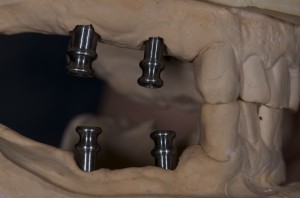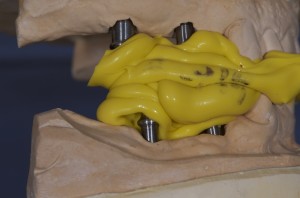Recent Posts
Bite Registrations-Teeth or No Teeth
Posted by on

 When restorative dentists have discussions about obtaining bite records for dental rehabs there rarely seems to be much debate over efficacious methodology. Maintain a central stop at the desired OVD and place your bite material. It can be done in segments while you remove quadrants of provisionals or the entire arch if you can maintain a stop.
When restorative dentists have discussions about obtaining bite records for dental rehabs there rarely seems to be much debate over efficacious methodology. Maintain a central stop at the desired OVD and place your bite material. It can be done in segments while you remove quadrants of provisionals or the entire arch if you can maintain a stop.
Now remove the teeth and what happens? Removable bases? Now place some implants which are more rigid than teeth and what do you have? No consensus that’s for sure! Enter the implant bite post (IBPTM). They have been mentioned on this blog before but their significance may be glossed over. Would any of you EVER go back to the old days fixing teeth? Hand articulation, wax and ZOE bites. Why then are implants considered anything different than rigid teeth? As discussed in more detail in the January 2013 Compendium article on this very subject (see link at end of blog) we can’t simply use techniques employed with removable prosthodontics and adapt them to fixed implant restorations and expect even remotely accurate occlusal outcomes.
 The simplicity of the IBPTMis readily apparent during clinical usage. At the impression appointment we already have our secondary healing caps or transitional abutments off and we will place impressions copings for the impression. Following the impression we will remove the impression copings and it is the perfect time to use the IBPTM. Screw them in using gentle finger pressure until they slip in your glove. Place one for each implant and check for occlusal clearance. In an attempt at reducing inventory you may want to always go with short bite posts but occasionally in the maxilla you will have a condition where the soft tissue will cover the retentive portion of the bite post index requiring a longer post.
The simplicity of the IBPTMis readily apparent during clinical usage. At the impression appointment we already have our secondary healing caps or transitional abutments off and we will place impressions copings for the impression. Following the impression we will remove the impression copings and it is the perfect time to use the IBPTM. Screw them in using gentle finger pressure until they slip in your glove. Place one for each implant and check for occlusal clearance. In an attempt at reducing inventory you may want to always go with short bite posts but occasionally in the maxilla you will have a condition where the soft tissue will cover the retentive portion of the bite post index requiring a longer post.

Once all of your bite posts are in place with acceptable clearance go ahead and record your bite exactly as you would when recording over teeth preps. Remember that you need to inject more forcefully around the IBPTMto ensnare the undercuts. Remove the bite record when it’s set and unscrew the bite posts. Depending on the implant connection you may require the use of a hex driver to loosen them. Save the bite posts and send them to the lab with your other records.
 Wow how life just got easier! Recording a bite on implants is so fast UNLESS of course your implant system does not use IBPTM. During a recent full–arch impression and bite acquisition I dealt with an implant system that has yet to incorporate the IBPTMand I was in a quandary as to how to incorporate an analogous rigidly attached, removable “bite post thing”. Within the same implant company there were two different implant designs and three different diameters of implants (hey I inherited the case).
Wow how life just got easier! Recording a bite on implants is so fast UNLESS of course your implant system does not use IBPTM. During a recent full–arch impression and bite acquisition I dealt with an implant system that has yet to incorporate the IBPTMand I was in a quandary as to how to incorporate an analogous rigidly attached, removable “bite post thing”. Within the same implant company there were two different implant designs and three different diameters of implants (hey I inherited the case).
 Well for two of the implants there were uni-abutment converters, which did provide indexed plastic casting sleeves that I could screw down and trim to length. For the remaining (too many) implants I had to use left–over or spare (from the previously completed maxilla) impression copings that I modified to length for dual-purpose impression and bite post usage. Some of the modified posts were ruined for the open tray impression technique though.
Well for two of the implants there were uni-abutment converters, which did provide indexed plastic casting sleeves that I could screw down and trim to length. For the remaining (too many) implants I had to use left–over or spare (from the previously completed maxilla) impression copings that I modified to length for dual-purpose impression and bite post usage. Some of the modified posts were ruined for the open tray impression technique though.
 The bite was taken prior to the impression because some of the impression copings that were modified or customized into “screwed-on bite posts” would stay in the impression. This required double and triple checking the available parts so as not to run out on the fly. The problem was, I wasted two hours.
The bite was taken prior to the impression because some of the impression copings that were modified or customized into “screwed-on bite posts” would stay in the impression. This required double and triple checking the available parts so as not to run out on the fly. The problem was, I wasted two hours.
 That’s not profitable and we are in BUSINESS to profit while we help human beings. So the take home lesson is, IBPTMnot only make the job of getting accurate bite registrations more easily, they make it faster and MORE profitable. Once you go through the door of knowledge you can’t ever go backwards
That’s not profitable and we are in BUSINESS to profit while we help human beings. So the take home lesson is, IBPTMnot only make the job of getting accurate bite registrations more easily, they make it faster and MORE profitable. Once you go through the door of knowledge you can’t ever go backwards
 Loading... Please wait...
Loading... Please wait...
